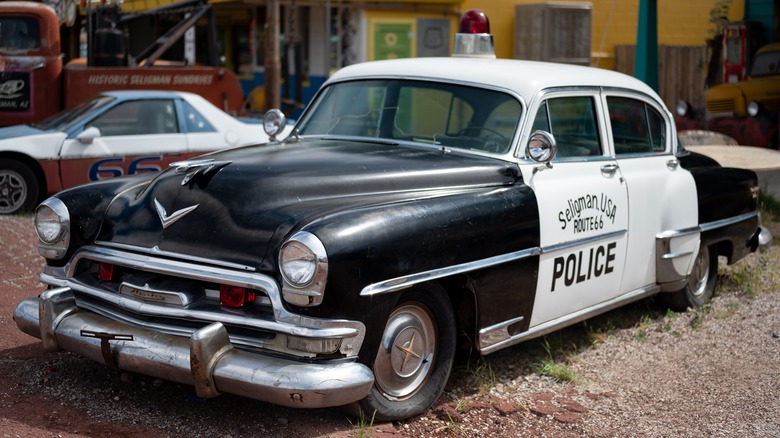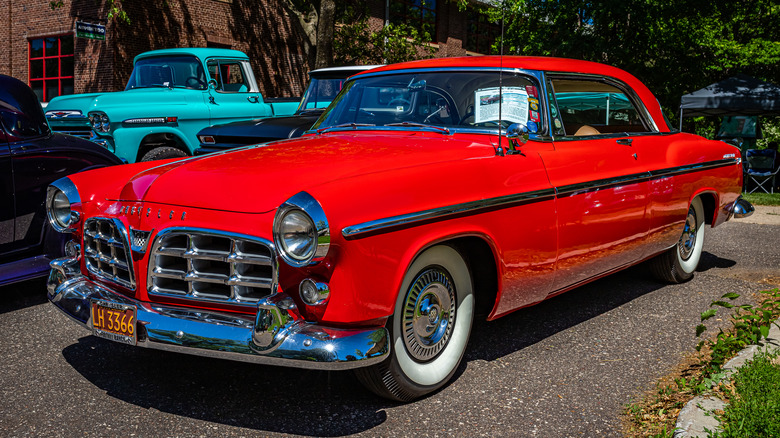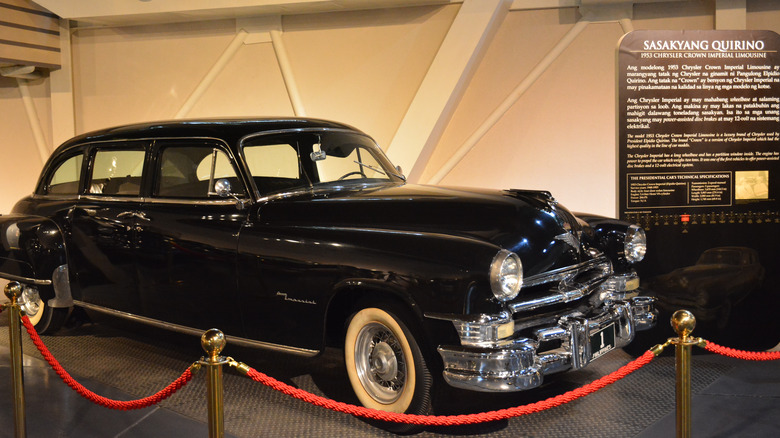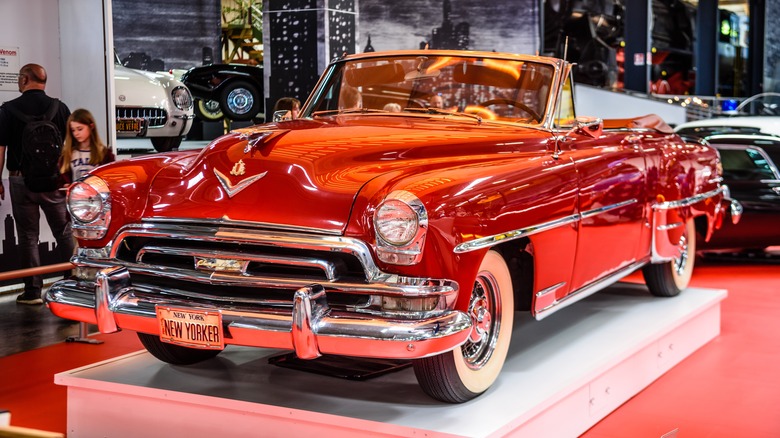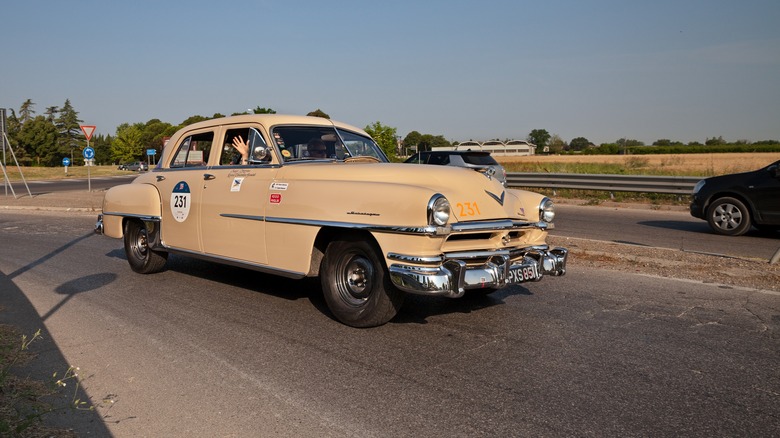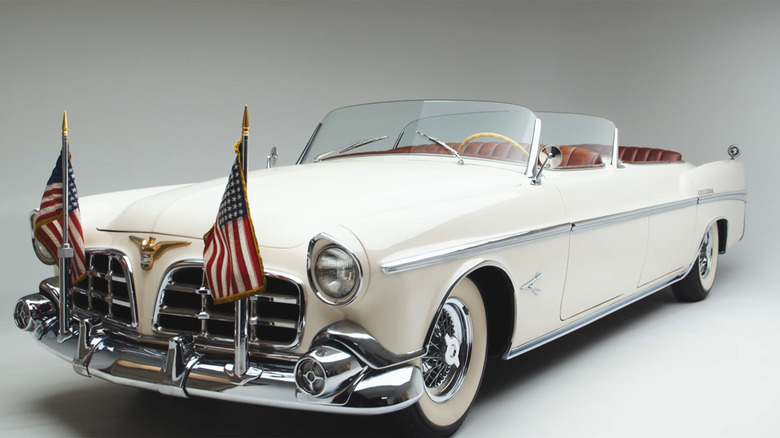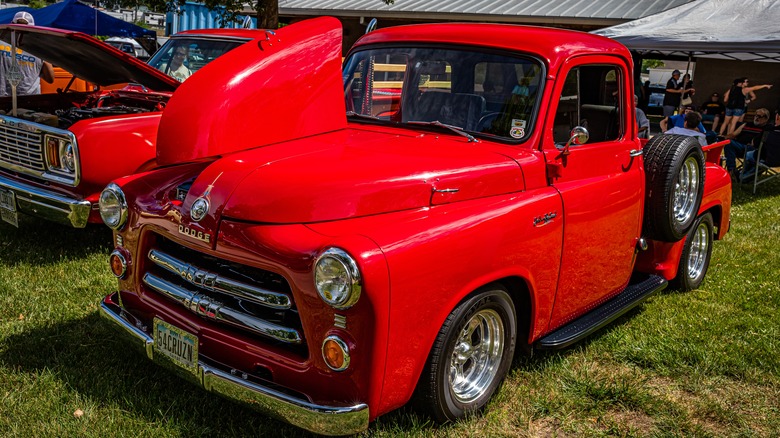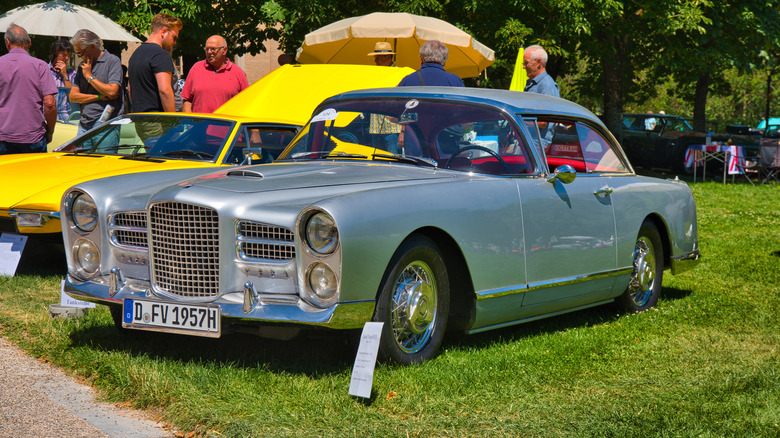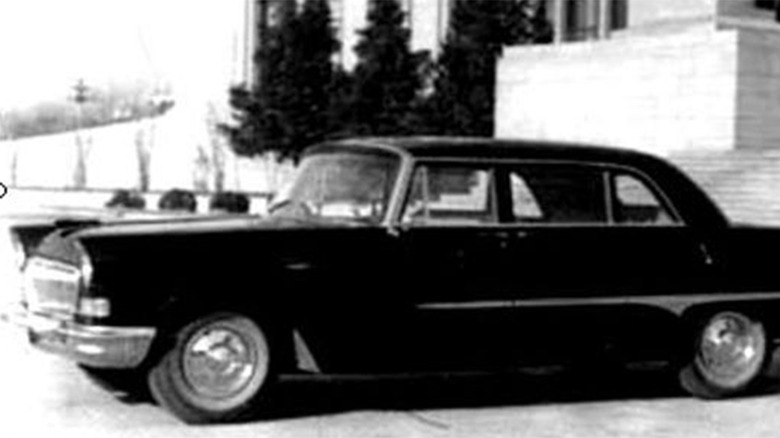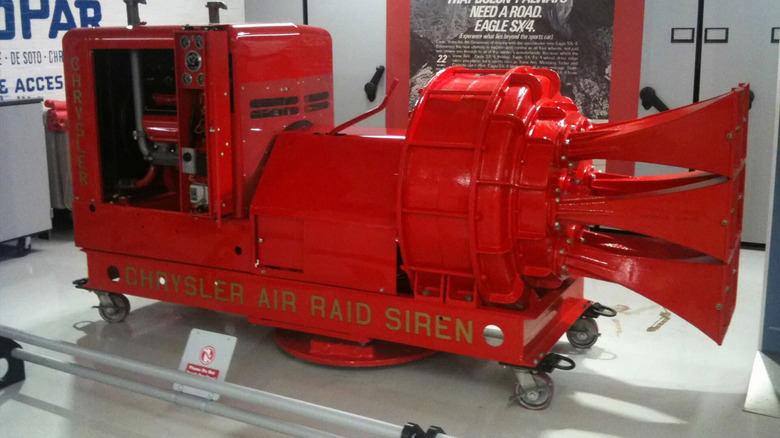Every Vehicle (And Non-Vehicle) Powered By The 331 HEMI Engine
Chrysler built engines for a very long time. The automaker started its journey in 1924 and continued production of engines until Stellantis took over operations in 2021. In the near century of making engines, Chrysler had some of the coolest and most powerful engines in existence. In fact, Chrysler is often cited as the reason the Hemi-style engine became popular. Chrysler used the design during World War II and brought the Hemi back as early as the 1950s. It's a mainstay in several vehicles, including Dodge and other Stellantis vehicles.
That brings us to the Chrysler 331 Hemi, often known as the FirePower. It's not among the most powerful Hemi engines that Chrysler ever built, but it is a very important and special engine. It's the first Hemi engine that Chrysler built and put into consumer vehicles. Chrysler built the 331 cubic inch V8 from 1951 through 1958, although the automaker only put the engine in its own cars until 1955. The engine was powerful in its day, heralding 180 horsepower and 312 lb-ft of torque at its worst and 300 horsepower and 345 lb-ft of torque at its best. The cast iron engine was only put in a handful of cars, but all of those cars are collector's items if you can get your hands on them.
1955 Crysler 300
The 1955 Chrysler 300 is the most powerful car to run the Chrysler 331 Hemi. It produces 300 horsepower and 345 lb-ft of torque with the 331 Hemi, as it was tuned to produce more power than the standard version of the engine. The modifications included a race-oriented camshaft, a larger dual exhaust, and it had two four-barrel carburetors. Chrysler also reportedly made the suspension firmer on the Chrysler 300 so that it could go faster than other cars of its era while remaining stable on the road. The company christened the car the Chrysler 300C, a moniker it has since brought back in newer models of the Chrysler 300.
The Chrysler 300 was born and bred for NASCAR racing, an endeavor the car and its drivers performed admirably. At one point, Mercury Outboard founder Carl Kiekhaefer purchased a small fleet of white Chrysler 300s for use in racing, where Kiekhaefer's drivers won dozens of races and several championships. It also performed the NASCAR flying mile at a top speed of 127.58 MPH and averaged 92 MPH in the Daytona Grand National stock car race.
America, however, wasn't yet ready for the era of the muscle car, and the 1955 Chrysler 300 sold less than 2,000 units in the only year where it had the 331 Hemi. Some gearheads posit that the ride was too firm for the average driver, and that they eventually opted for different Chryslers with less powerful versions of the same engine that also rode nicer on regular roads.
1951-55 Chrysler Imperial
One car shoppers may have gone to instead of the Chrysler 300 is the Chrysler Imperial. Chrysler made this car for several decades, beginning in 1926 and ending in 1993. The only models to carry the 331 Hemi was from 1951 through 1955. Much like the Chrysler 300, the Imperial's variant of the 331 Hemi had more horsepower than the base model, producing 250 horsepower and 340 lb-ft of torque at the height of its power. It was no race champ, but it represented Chrysler's luxury lineup and prioritized comfort.
In 1951, the Chrysler Imperial was a fairly luxurious car to own. Its price range was from $3,661 to $4,402, which put it higher than Cadillac or Lincoln back. That priced some customers out of the car but those who could afford it were treated to a very comfortable car. Conversely, the least popular variant of the Imperial was the convertible model, which reportedly sold only 650 units in 1951 before it was dropped from the lineup entirely. The convertible is thus now one of the most sought-after versions of the car, thanks to its rarity.
Chrysler also made the Crown Imperial during these years, and even more upscale version of the Imperial that was on a longer wheelbase. The other two models were the two-door hardtop and the four-door Imperial Sedan. Imperials of this generation didn't even come close to outselling segment leaders like Cadillac, but Chrysler would hit its stride with the Imperial.
1951-55 Chrysler New Yorker
While the Imperial was too expensive for many consumers, the Chrysler New Yorker was much more successful. Reportedly, the car was either the best or second best-selling car that Chrysler put out from 1951 through 1955 when the car ran the 331 Hemi. Unlike most of its contemporaries, Chrysler used different variants of the 331 Hemi in the New Yorker. The '51, '52, and '53 models had the base model with 180 horsepower. In 1954, the engine upgraded to 195 horsepower, while 1955's New Yorker Deluxe had 235 horsepower, which is the most powerful New Yorker with a stock 331 Hemi.
The Chrysler New Yorker was one well-built car. The engine was reliable, and the car was designed in such a way that rust was uncommon. It could easily go hundreds of thousands of miles provided that proper maintenance was done. Chrysler built the car to compliment its own Windsor. The Windsor was the hotter, smaller car that younger people liked more, while the New Yorker was made for older professionals looking for a more luxurious experience. Chrysler hit the nail on the head as the Windsor was the other bestseller from the early 1950s.
Much like the Imperial, Chrysler built the New Yorker for a long time. The company eventually put the New Yorker to bed in 1997 after several decades of production. The 331 Hemi era came and went without too much drama and was one of the most successful eras in the vehicle's history.
1951-52 Chrysler Saratoga
The Chrysler Saratoga was another long-running nameplate when the 1950s rolled around. Chrysler debuted the car in 1939, and it was positioned above the Imperial and the New Yorker in terms of luxury. Over time, the car shrunk from a 131.5-inch wheelbase in 1949 to a 125.5-inch by 1951. Like the New Yorker, the Saratoga had the 180-horsepower variant of the 331 Hemi, which it kept through the 1952 model year.
On top of being a joy to look at, the car itself was fairly popular. Production for the car was an estimated 45,500 combined in 1951 and 1952, which was a good number for Chrysler in those days, even if Windsor and the New Yorkers did better. The most popular model was the four-door sedan by a wide margin, with the Club Coupe model coming in a distance second. Fun fact: Chrysler also advertised an ambulance based on the Saratoga. According to production data, Chrysler made one of them, and it likely had the 331 Hemi installed.
Chrysler was always a bit finicky with the Saratoga nameplate. The car was discontinued after the 1952 model year and brought back in 1957 before it was discontinued again in 1960. It survived in Canada until 1965 and in Europe from 1989 to 1995. Chrysler reportedly found the car superfluous, as the New Yorker and Chrysler 300 carried the luxury and performance mantles, leaving the Saratoga without a niche to aim for.
1952 Chrysler Parade Phaeton
The 1952 Chrysler Parade Phaeton is one of the most unique vehicles with the 331 Hemi. It was originally built as a parade car for politicians, particularly U.S. presidents. The car borrowed the chassis, engine, grill, and bumpers from the Chrysler Imperial but had a ton of body and mechanical work done to make it usable as a parade vehicle. That includes the second windshield, a much longer wheelbase to keep passengers comfortable, and changes to the drivetrain so that the car would drive at low speeds for extended periods of time.
Three of these cars were made usable to the U.S. government. They were commonly referred to by the city where the car resided: New York, Los Angeles, or Detroit. Since the American government couldn't accept gifts at the time, Chrysler reportedly made these vehicles available to the government whenever it was needed but Chrysler retained ownership of the vehicles. Several presidents used this car, including Dwight D. Eisenhower and Richard Nixon. One of the cars is famous for carrying the Apollo 11 astronauts in 1969 and the Los Angeles was featured in several Hollywood movies.
These cars were used extensively and for a long time. Chrysler eventually retired one of the vehicles in 1970 and it was eventually purchased and placed in a museum. The other two were gifted to the cities of Los Angeles and New York where both vehicles have since been rebuilt and are still used to this day in official celebrations and parades.
1954 Dodge C Series
The 1954 Dodge C Series trucks are known for versatility. Over a dozen trims and variants were constructed in the mid-1950s, including the C1, C3, C4, Town Panel, Town Wagon, and several others. Thus, it is actually quite difficult to find an example of one being built with a 331 Hemi since the vehicles used a wide range of engines. However, if you picked up a 1954 Dodge C Series "Job-Rated" truck, it most likely came with a 331 Hemi. You know if the truck is job-rated if it has the words "Job-Rated" emblazoned on the side of the truck.
The job-rated versions didn't look like the other Dodge C Series trucks. They were most often extended or modified for specific work. We found several examples, including a yellow utility truck and a red C Series ramp truck. These versions of the Dodge C Series were built for work and had one of the most powerful and capable engines of the 1950s to do it. Reportedly, 331 Hemis in these trucks had around 200 horsepower and 311 lb-ft of torque.
Since job-rated trucks have so little in common with the rest of the lineup and since Dodge trucks were not the mainstays in American trucks that they are today, there isn't a ton of information available about the old Dodge C Series trucks. It also had a shorter lifespan with Dodge doing away with the C Series by 1960 in order to make room for different trucks.
1956 Facel Vega FVS
Much like the Dodge C Series trucks, the Facel Vega is a difficult car to find information about. Most of the variants in the 1950s ran one of Chrysler's engines, although many of them used the DeSoto engine. However, some models of the 1956 Facel Vega, including the FV2B, had the Chrysler 331 Hemi. Often, the car is referred to as having the same engine as the Chrysler 300 Hemi, which in 1955 was the 331. It was also commonly referred to as a 5.4-liter Chrysler V8 and the 331 Hemi was the only 5.4-liter V8 that Chrysler made in the 1950s. So, while it is difficult to find solid evidence that this car used a 331 Hemi, some evidence does exist.
According to multiple reports, the engine made around 285 horsepower in the Facel Vega. Facel went with the 331 Hemi because no French engines had enough horsepower to do what the automaker wanted: make a luxury car with better-than-average performance that carried the French automaking style at the time. The gambit worked as many famous artists, politicians, and other people of note owned Facel cars, including Pablo Picasso, Ava Gardner, Dead Markin, Frank Sinatra, and many others.
Facel made cars from the 1930s until the mid-1960s when it went out of business after falling behind the competition, particularly in the US. For that time, the brand was known for making some of the most unique cars of its day and collectors often put Facel cars next to classic Rolls Royce and other luxury automakers.
1958 Hongqi CA72
The 1958 Hongqi CA72 is one of the oddest vehicles on this list. It was made in China as the country's first independently produced car. It was also a prototype vehicle, so only a handful were made. The brand was looking to make cars that could compete with luxury automakers like Cadillac and Mercedes-Benz and chose to base its vehicle on the 1955 Chrysler Imperial. The Chinese automaker first had to get its hands on a Chrysler Imperial so they could figure out how to make something like it.
The automaker reportedly found one via the College of Automotive Engineering, which is part of the Jilin University of Technology. No one is quite sure how the Chrysler Imperial ended up there, but it was allegedly a gift for a Chinese politician who allegedly never used it. Once in hand, the automaker stripped the car down and rebuilt it using different parts. However, they kept the engine, transmission, and other drivetrain elements. Since the 1955 Imperial used the 331 Hemi, it's highly likely that the Hongqi CA72 also had it since it was essentially a deconstructed and rebuilt Imperial.
The brand has gone on to be successful enough to still be around to this day. Data isn't readily available in the Chinese car market, but Hongqi reportedly sold 300,000 cars in 2021, and another 296,000 in 2022 with a lineup of 11 different vehicles – not too bad for an automaker you probably never heard of until today.
The Chrysler Air Raid Siren
It shouldn't surprise anyone that we saved the best and most zany contraption for last. Chrysler build an air raid siren back in the 1950s to, as Jalopnik put it, "warn Americans of their impending nuclear doom." Chrysler started making air raid sirens with car engines as early as the 1940s. However, early iterations of the product were widely panned. In one example, San Antonio bought five sirens for $20,000, which is over $350,000 when adjusted for inflation, and weren't satisfied with the performance.
Chrysler made the air raid siren with the 331 Hemi, and my goodness is this thing loud. It's capable of discharging 2,610 feet of air per minute at seven PSI. It was powerful enough to blast birds from the sky and the military even used it at one point to move fog. It could make 138 decibels of noise from 100 feet away, and could be heard as far away as 25 miles. However, many of them required manual controls, meaning one person had to operate the thing until the hypothetical nuclear blast showed up.
Chrysler says that 350 total air raid sirens exist, although independent research puts that number closer to 108 total documented sightings of the siren across history. There is a neat map that you can use to see where they were, and which ones are still in operation to this day. It still holds the Guinness world record as the loudest air raid siren ever produced.
[Image by User PBMI via Wikimedia Commons | Cropped and scaled | CC BY-SA 3.0]
